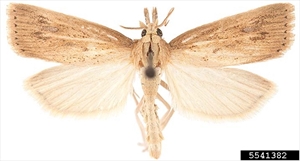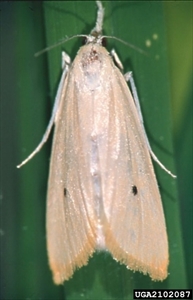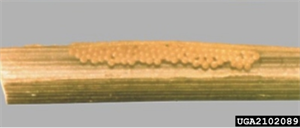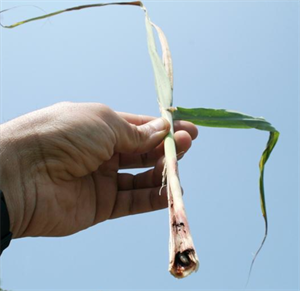- Restricted. South, East and Southeast Asia, North America (Hawaii), Europe, Oceania. In Australia, Papua New Guinea.
- Severe on rice, sorghum, maize, but also on sugarcane, millet, and wild grasses.
- Larvae tunnel through internodes of stem to the growing point, killing it; stems pull out easily (‘deadhearts’). Panicles fail to emergence, or panicles emerge with white unfilled grain (‘whiteheads’).
- Eggs (scale-like) up to 60 in several rows, yellow, laid on leaves. Larvae, yellowish, with five longitudinal purple to brown stripes, brown heads, 25 mm long. Disperse on silk threads. Adult forewings yellowish-brown, dark flecks and marginal black dots; hindwings whitish. Spread on the wing. Nocturnal.
- Natural enemies: many egg and larval parasitoids and predators.
- Biosecurity: introduction possible on produce contaminated with infested stems of host plants.
- Cultural control: plough land well (IMPORTANT to bury larvae/pupae of previous crop); plant at higher density than normal; rotate two crops rice then fallow, or plant maize, soybean or peanut; synchronise plantings with neighbours; submerge eggs by raising water occasionally; weed; apply split applications N; harvest at ground level to remove larvae; plough in stubble, unharvested plants and weeds; use resistant (short, high tillering, early maturing) varieties.
- Chemical control: use abamectin, or tebufenozide to disrupt moulting. Avoid broad-spectrum insecticides to preserve natural enemies.
Pacific Pests, Pathogens and Weeds - Online edition
Pacific Pests, Pathogens, Weeds & Pesticides
Rice striped stem borer (412)
Striped rice stem borer; it is also known as the Asiatic rice borer.
Chilo suppressalis. A moth in the Crambidae.
AUTHOR Grahame Jackson
Information (and Photo 4) from Rice Knowledge Bank. IRRI. (http://www.knowledgebank.irri.org/training/fact-sheets/pest-management/insects/item/stem-borer); and CABI (2019) Chilo suppressalis (striped rice stem borer). Crop Protection Compendium. (https://www.cabi.org/cpc/datasheet/12855); and Pathak MD, Khan ZR (1994) Insect Pests of Rice. IRRI/ICIPE.(http://books.irri.org/9712200280_content.pdf); and from Chilo suppressalis. Wikipedia. (https://en.wikipedia.org/wiki/Chilo_suppressalis). Photo 1 Asiatic rice borer (Chilo suppressalis) Todd Gilligan, Screening Aids, USDA APHIS PPQ, Bugwood.org. Photos 2,3&4 Asiatic rice borer (Chilo suppressalis) International Rice Research Institute, Bugwood.org.
Produced with support from the Australian Centre for International Agricultural Research under project HORT/2016/185: Responding to emerging pest and disease threats to horticulture in the Pacific islands, implemented by the University of Queensland and the Secretariat of the Pacific Community.








